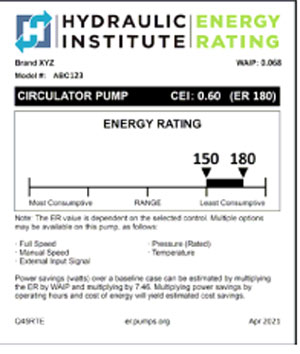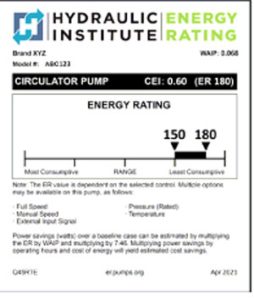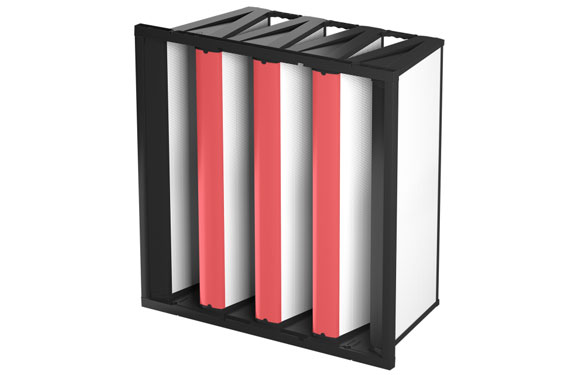
Much like the switch from incandescent to LED light bulbs, there has been a paradigm shift in the technology of circulator pumps used for heating and cooling applications that vastly improves efficiency. Contractors and installers of these pumps, which are installed in the millions per year and are used in numerous residential and commercial applications, can now take advantage of improvements that significantly reduce energy use and overall costs for their residential and commercial customers. The technological advancements also improve overall performance and system efficiency, leading to enhanced end-user comfort and satisfaction while making the transition even more attractive.
Circulator pumps are used for a myriad of applications such as heating homes, schools and businesses and pumping domestic hot water. Traditionally, these pumps have lower relative efficiency due to the application requirements of low flow rates, pressures, and motor size. Realizing a technology shift to a more efficient circulator pump can therefore have a dramatic effect at scale on lowering energy costs, and ultimately for reducing greenhouse gas emissions. By building and leveraging energy rebate programs effectively, contractors, installers and utilities can realize significant energy and cost-savings for their customers.
The switch to electronically commutated motors
The technology shift for circulator pumps comes in the form of electronically commutated motors (ECM’s). These motors offer significant performance improvements over permanent split capacitor (PSC) motors, which have traditionally been used.
When replacing a PSC-driven circulator with an ECM-driven circulator, an end-user can expect to achieve up to 80 percent savings in electrical energy. For starters, ECM’s provide an efficiency step change by their design, which utilizes permanent magnets in the rotor thereby eliminating these losses. The efficiency benefits become greater at reduced speeds and loads. Unlike PSC motors, ECM’s require integrated electronic circuitry and variable frequency drive to operate. This is a primary reason for their increased cost, but also makes them inherently variable speed capable, which is the reason they can save so much energy and improve system performance.
As mentioned, the hallmark of ECM’s is their inherently variable speed controls. This feature enables them to react to a system demand by speeding up or slowing down resulting in the most efficient system operation. From the consumer standpoint, a single circulator pump has the effect of being able to provide heating to one zone or multiple zones in a given space, by sensing the system demand (i.e. three zones open versus one zone open) and speeding up or slowing down to meet that system demand. A typical control methodology for these pumps is pressure, and most of the ECM circulator pumps have integrated sensorless controls meaning there is no need for external instruments, wiring or pipe modifications. This integrated technology has earned these pumps the broad category of ‘smart pumps’ by the trade for differentiating them from older PSC-based product.
Rating system offers critical tool for specifiers
In other markets such as Europe, there has been greater adoption of ECM’s, but the North American market is catching up. One way this is being accomplished is through a new rating system for circulator pumps. This system offers specifiers, designers, contractors, distributors and end-users the ability to clearly and easily identify the efficiency of a given pump, and its potential for cost-savings. The Energy Rating label provides a comparison based on the relative energy usage of a basic pump model compared to other basic models, and it can help users identify the savings across a pump’s entire life cycle. The higher the rating, the greater the savings.
The rating system, developed by the Hydraulic Institute and available in pump sales literature and packaging, is based on research in the public domain and in accordance with widely accepted industry standards. Essentially, each rating is intended to provide the energy use and cost-savings as transparently and accurately as possible for the end-user.
In determining a rating, circulator pumps are tested both for their electrical input and hydraulic output powers. Measurements are taken at maximum speeds as well as at reduced speeds based on a pump’s onboard controls. Testing is designed to simulate the variable control modes within ECM circulator pumps, which increase and decrease their speeds based on pressure, temperature, or other system variables. Because ECM pumps can reduce speed and have higher efficiency at lower speeds, the Energy Rating compares their power consumption at reduced speed points versus the full speed points of a typical PSC circulator.
 Image 1 provides an example label for a small residential circulator pump that yields an energy rating range of 150 to 180. The range reported on the label is very similar to the highway and city miles per gallon you see when purchasing a new car. The same concept applies to circulators, where the power consumption depends on how they are operated (i.e. onboard controls). The Energy Rating of 180 rating represents the most efficient control method onboard and can be estimated to provide a power savings of 91 watts over the baseline circulator. This estimate is then used to determine the approximate cost-savings based on the average operating hours and cost of electricity in the USA, yielding an annual savings for the pump at $36.30. While this is an estimate, it is based on trusted performance and operating hour data using widely accepted testing criteria. This is a reliable tool for electric utilities to provide purchase incentives to help transition the market, which will reduce energy consumption and carbon emissions in their region. Secondarily, it is valuable to help communicate to the customer the relatively short pay off period and long-term costs savings.
Image 1 provides an example label for a small residential circulator pump that yields an energy rating range of 150 to 180. The range reported on the label is very similar to the highway and city miles per gallon you see when purchasing a new car. The same concept applies to circulators, where the power consumption depends on how they are operated (i.e. onboard controls). The Energy Rating of 180 rating represents the most efficient control method onboard and can be estimated to provide a power savings of 91 watts over the baseline circulator. This estimate is then used to determine the approximate cost-savings based on the average operating hours and cost of electricity in the USA, yielding an annual savings for the pump at $36.30. While this is an estimate, it is based on trusted performance and operating hour data using widely accepted testing criteria. This is a reliable tool for electric utilities to provide purchase incentives to help transition the market, which will reduce energy consumption and carbon emissions in their region. Secondarily, it is valuable to help communicate to the customer the relatively short pay off period and long-term costs savings.
Image 1 Circulator Pump Label
This rating system is an invaluable tool to help spread marketplace awareness and acceptance of modern circulator pumps. Put simply, this system represents the power savings equitably and fairly, and that’s a benefit for contractors, installers, utilities, and their customers.
Switching from a traditional circulator pump to an ECM-driven pump with an Energy Rating label yields a significant cost-savings to consumers. But, when considered at scale across different industries, it represents not only a paradigm shift in technology, but a potential breakthrough in sustainability and in reducing the global carbon footprint. In fact transitioning the market to more efficient circulators and on-board controls can offset the CO2 emissions from more than 1-billion gallons of gasoline, and save consumers more than $1-billion dollars over the circulators life time.
Learn more about HI’s Circulator Energy Rating Program and search the database of rated pumps here. HI’s full ecosystem of energy efficiency solutions includes training, certification programs, and standards. For more information on these programs, please visit pumps.org/Circulator.
Testimonials
“It is a great way to publish the efficiency of our circulators from our variable speed offering to our multi-speed products. A similar program to other HVAC offerings and the Energy Star efficiency program, the HI labelling is an option for customers to see efficiency levels from a trusted 3rd party. This is also a tool for utilities to easily look up energy data for each supplier,” says Ryan Coppola, Offering Specialist, Circulators, Valves and Hydronics, Armstrong Fluid Technology.
“The Hydraulic Institute’s Circulator Energy Rating Program provides an excellent means for end-users and installers to easily select energy efficient pumps for their homes and businesses, helping them obtain energy and operating savings. This is in strong alignment with our own sustainability ambitions at Grundfos, driving water and energy efficiency for the greater good,” says Adam Schwarz, Global Product Manager, Grundfos.
“Achieving market transformation to a new technology, no matter how much better it is, can be difficult. The HI Energy Rating provides all industry stakeholders with a simple yet trusted method for evaluating energy savings. This should help accelerate adoption of these ECM circulators and a provide significant environmental impact benefiting all of us,” says Mark Chaffee, VP Governmental Affairs and C&I Product Management for Taco Comfort Solutions.
“The Hydraulic Institute Circulator Energy Rating Program provides a non-partial standardized method to compare the cost of energy usage for all circulators. This allows engineers, distributors and wholesalers, dealers and installers, and end user customers choices to select the highest efficiency circulator pumps to solve their problems and optimize system efficiency and energy usage. By choosing high efficiency products we ensure a sustainable future,” says Christopher Johnson, SR. Director of Product Engineering – Americas for Xylem.
About the Hydraulic Institute (HI)
The Hydraulic Institute (HI) centers the pump industry around excellence and efficiency to power everyday life. HI’s mission is to advance the pump manufacturing industry by becoming the world’s resource for pumping solutions and advancements in the industry by: Addressing Pump Systems, Developing Standards, Expanding Knowledge and Resources, Educating the Marketplace and Advocating for the Industry. For more information on the Hydraulic Institute, visit www.pumps.org.














